

- None.
Division of Planetary Science's Amateur-Professional Workshop
The 1998 meeting  of
the Division of Planetary Sciences of the American Astronomical Society
included a session on Amateur Professional Cooperation, chaired by J.
Kelly Beatty of Sky and Telescope magazine. Kelly started out the
session by introducing the subject. He pointed out that most planetary
astronomers probably started out their lives as amateur astronomers who
were fascinated by the sky. Kelly claimed that most astronomers probably
started out that way, except possibly for the astrophysicists, who he
drolly claimed are always "way out there". Jokingly, Kelly then observed
that the difference between amateurs and professionals is that professionals
have PhDs, and amateurs have day jobs.
of
the Division of Planetary Sciences of the American Astronomical Society
included a session on Amateur Professional Cooperation, chaired by J.
Kelly Beatty of Sky and Telescope magazine. Kelly started out the
session by introducing the subject. He pointed out that most planetary
astronomers probably started out their lives as amateur astronomers who
were fascinated by the sky. Kelly claimed that most astronomers probably
started out that way, except possibly for the astrophysicists, who he
drolly claimed are always "way out there". Jokingly, Kelly then observed
that the difference between amateurs and professionals is that professionals
have PhDs, and amateurs have day jobs.
 Amateurs today have access to instruments that are at least as large as
the ones that most professionals can access. Amateurs that have obtain
CCD equipment that is almost as good as the professionals have. Today
the amateur can also use the Internet and e-mail to get access to the
same information that the professionals have, including catalogs, announcements,
and professional papers.
Amateurs today have access to instruments that are at least as large as
the ones that most professionals can access. Amateurs that have obtain
CCD equipment that is almost as good as the professionals have. Today
the amateur can also use the Internet and e-mail to get access to the
same information that the professionals have, including catalogs, announcements,
and professional papers.
Kelly then introduced famed comet discoverer David Levy. David talked about amateur astronomers and how they relate to professionals. Amateur and professionals are not that much different until you get up to the level of observatory director. Until then, the observer (amateur or professional) goes to bed thinking about observations, gets up thinking about observations, and spend his/her day thinking about and doing observations.
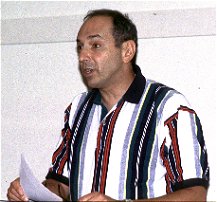 When
you get to the observatory director level, you start to think about other
things that an amateur would never have to think about, like funding,
telescope time allocation and more. Observers who reach this level and
above are responsible for promoting their institution and attempt to differentiate
it from other all others. Even so, after his retirement Bart Bok is quoted
as saying "I am an amateur, I started as an amateur, I dabbled for thirty
to forty years as a professional, and now I am an amateur again."
When
you get to the observatory director level, you start to think about other
things that an amateur would never have to think about, like funding,
telescope time allocation and more. Observers who reach this level and
above are responsible for promoting their institution and attempt to differentiate
it from other all others. Even so, after his retirement Bart Bok is quoted
as saying "I am an amateur, I started as an amateur, I dabbled for thirty
to forty years as a professional, and now I am an amateur again."
Next Don Parker famed amateur planetary imager acquainted us with his organization, the Association of Lunar and Planetary Observers. This group has more than 500 members worldwide in 42 countries. They have sections on the sun, moon, planets, meteors, comets and instruments. Their main purpose is to gather data, specifically quantitative data. To achieve this goal, ALPO has a training program, section manuals, and professional advisers. One ALPO member, Richard Schmude, is presenting a paper at the DPS meeting on "Seasonal Changes in Sporadic Meteor Rates".
 There
are four services that ALPO can provide. First is continuous observation
of solar system objects for many years, documenting the changes on the
planetary discs. They have recorded more than 25,000 observations of clouds
on Mars from 1969 to the present. They continue to make these observations
not only through photographs and excellent CCD images, but through filar
micrometric observations.
There
are four services that ALPO can provide. First is continuous observation
of solar system objects for many years, documenting the changes on the
planetary discs. They have recorded more than 25,000 observations of clouds
on Mars from 1969 to the present. They continue to make these observations
not only through photographs and excellent CCD images, but through filar
micrometric observations.
Another service is an early warning system. Dust storms, spot eruptions and other events are often first observed by amateur astronomers. Their historical records allow a current event on a planet to be compared to similar events that have occurred in the past. For example, the Mars Pathfinder landing was threatened by a dust storm on Mars. Searching the ALPO archives of previous observations of the same type of storm in ALPO records allowed them to determine that the dust storm would not affect the selected landing site and they did not need to select a new landing zone for the Pathfinder.
ALPO members can also do special projects, such as a daylight imaging of the Jupiter to get images of the clouds during the Galileo spacecraft's probe entering the Jovian atmosphere.
Drawings, photographs, timings, micrometry, photometry, video, and CCD images are all collected by ALPO. Last Mars apparition, 41% of the images collected were CCD images rather than visual observations. CCDs have allowed photography to reach the resolution level of visual images. Tiny spots that only visual observers could record on their drawing can now be recorded with CCD systems.
Observers have also taken the message of quantitative data to heart. They are starting to use wavelength bandpass filters to capture images and drawings in specific parts of the spectrum, all they way from the infrared to the ultraviolet. This allows the professional astronomers to learn more about the planets from the more detailed observations.
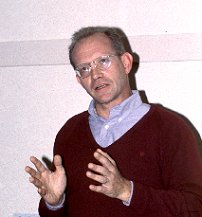 Tom
Dobbins discussed video astronomy. This technique allows the amateur to
defeat the problem of seeing, allowing the capture of diffraction-limited
images. Early attempts at doing this used motion picture equipment. After
taking many hundreds of hours of film, French observers were able to show
some short sequences when the seeing stabilized that show some of the
best images of the planets ever taken. Film was replaced with video tape
at the Corrolitos Observatory just outside Las Cruces, NM, where a state-of
the art video imaging system was used to get images of the Moon and planets.
Their main goal was a search for lunar transient phenomena. Unfortunately,
they were never able to find any, but they did learn just how difficult
it is to prove a negative.
Tom
Dobbins discussed video astronomy. This technique allows the amateur to
defeat the problem of seeing, allowing the capture of diffraction-limited
images. Early attempts at doing this used motion picture equipment. After
taking many hundreds of hours of film, French observers were able to show
some short sequences when the seeing stabilized that show some of the
best images of the planets ever taken. Film was replaced with video tape
at the Corrolitos Observatory just outside Las Cruces, NM, where a state-of
the art video imaging system was used to get images of the Moon and planets.
Their main goal was a search for lunar transient phenomena. Unfortunately,
they were never able to find any, but they did learn just how difficult
it is to prove a negative.
CCDs and video cameras are rapidly replacing the photographic film technique of planetary imaging. Cameras that would be very expensive if built only for astronomers, have become cheap because they are also being built for many other uses including security and microphotograhy, where they want to get high resolution images at low light levels, since they do not want to fry their specimens.
Amateur astronomers can purchase these cameras and easily attach them to their telescopes. The amateur can then record the video and capture the images on a computer. Picking off the best frames, they can be combined to create a single image that "smooth-out" the noise of the individual frames. The resulting images are of excellent quality for publication.
For presentations, showing the video tape gives the spectators a sense of seeing them live that just cannot be provided in still images. For amateurs, reading out images is a way to spend cloudy nights, searching through the video tape to find the best frames. Video images cannot provide the photometric data that CCD can, but the newer digital CCD cameras may perhaps provide better quantitative data. Tests will need to be performed to determine if this is so. But even so, position angles, and distances can be more easily read off a TV with a ruler than at an eyepiece with a filar micrometer.
Dennis diCicco of Sky and Telescope has met thousands of amateur astronomers from all over the country. The primary thing that amateurs bring to the table is aperture and time. Amateurs have as much aperture available to them as many professionals do. They also have plenty of time, since most of them do not have "a life". Computers and the Internet have brought the amateur to the level where they can be mobilized quickly to observe a transient event. They also have the computer power that most professionals did not have even five years ago.
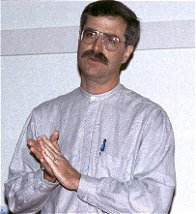 One
of the things that the amateur needs is guidance from the professional
about what projects to get involved in. They also need better software
to allow them to take photometric measurements. There is already good
software to do astrometry, but there are many ways you can go wrong in
photometry and the amateur needs to have software that will help them
not make obvious mistakes in reducing the observations. Spectrophotography
is also starting to come "on-line" and there is a great need for software
in this area.
One
of the things that the amateur needs is guidance from the professional
about what projects to get involved in. They also need better software
to allow them to take photometric measurements. There is already good
software to do astrometry, but there are many ways you can go wrong in
photometry and the amateur needs to have software that will help them
not make obvious mistakes in reducing the observations. Spectrophotography
is also starting to come "on-line" and there is a great need for software
in this area.
Dennis is currently using a 16-inch Newtonian with a CCD camera. This allows him to take great images in very light-polluted skies of Boston. This equipment will record objects down to 22ndmagnitude. The Palomar 200-inch telescope could only get 21st magnitude with the technology available when it was completed in 1948!
Software today allows astrometry to be done very quickly and efficiently with the equipment available today. Dennis got some astrometric software, loaded it into his computer, took some CCD images, and plotted their positions with the software. He then sent his observations to Harvard Observatory where they publish the IAU Circulars by e-mail, just asking what they thought of his measurements. A few minutes later he received a return e-mail assigning him an astrometric station code.
He has also been able to observe both the proper motion, and parallax of Barnard's Star. He continued his astrometry, targeting critical minor planets in needed of observation. In the process, he began to discover new minor planets. This occurred before the professional minor planet searches started running. They are sweeping up minor planets like crazy.
The Minor Planer Center is available to help people get started on astrometry. They have Web pages that will help you get started, lists of objects, and a near-earth object page (NEO). The NEO page has new nearby objects that need immediate observing. Amateurs can monitor this page, compute their local ephemeris and take observations that same night. When an object gets posted on the NEO page, amateurs monitoring the page almost immediately begin providing astrometric observations of the object. This allows an orbit to be computed in short order.
Amateurs with normal-sized telescopes can get a 10:1 signal-to-noise ratio on even 19thmagnitude objects with today's equipment. The professionals need to provide guidance and training to the amateur. The professional must engage in "out-of-the-box" thinking that will find new ways for the amateur to contribute to the science of astronomy.
Steve Edberg, who ran the International Halley Watch in the mid-1980s next talked about the infrastructure needed to coordinate amateur and professional interaction. Steve was president of the WAA at the time that Halley was approaching perihelion. The first thing that he did was to write a "recipe book" on how to observe the comet, the "International Halley Watch Amateur Observer's Manual for Scientific Studies".
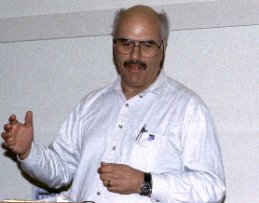 He
then created a registration form for the amateur to fill out. Many times
the amateur would get his/her name right, but the address and telephone
number were more uncertain. When it came to observing sites, four were
not enough and Steve said even he came up with some twenty sites for his
observations. A very important part of the form was to get permission
to use the observations. Without this permission, the observations could
not be used in research papers.
He
then created a registration form for the amateur to fill out. Many times
the amateur would get his/her name right, but the address and telephone
number were more uncertain. When it came to observing sites, four were
not enough and Steve said even he came up with some twenty sites for his
observations. A very important part of the form was to get permission
to use the observations. Without this permission, the observations could
not be used in research papers.
For future amateur-professional cooperation it should be agreed between the amateur and the professional how the observations will be attributed to the amateur at the beginning of the project. This could range anywhere from mentioning the amateur in the "acknowledgments" to adding them to the list of authors of the paper.
Instructions need to be written in a way that is very clear, even to new observers. Experienced observers will sometimes not read the instructions thinking that they already know how to take the observations and will make incorrect measurements. In order for the data to be useful, the data must be gathered correctly.
Standardizing the data is another major problem. People do not always follow the recommendations on how to process the film, and even the commercial processors will process the same film in different chemicals. One example was the use of D-19 in the US and D-19B in Europe. The chemical formulae of these two similarly-named developers are not very similar at all. Finding the formulae for these two was difficult at the time Halley passed us, ten years from now, astronomers looking at the photographs may be completely unable to reconstruct how the film was processed. This problem even stretches to the software used to analyze the data. How do you treat observations reduced with "home-brew" software? Do you include it "as-is", or do you insist that the amateur use a standardized program.
The Amateur Participation in the Hubble Space Telescope is another example of a project in which amateurs were involved. The Space Telescope Science Institute (STScI) provided forms and instructions on how to make proposals. But some of the requested information on the forms could not be easily computed by the amateur. In addition, professional astronomers were not available to help direct the amateur in their research. The professional institutions also need to understand that the amateur is not a professional and cannot be expected to react in the accepted "professional" way. This can make professionals uneasy in dealing with amateurs. Amateurs and professionals must both make allowances for the attitudes and presumptions of the other.
 Jim
Bell was next, talking about the Marswatch at Lowell Observatory near
Flagstaff, AZ. This project brings together professional and amateur astronomers
that regularly observe Mars. Mars Pathfinder encouraged many observers
to looking at Mars on a regular basis. This Marswatch program was linked
off the Pathfinder website and allowed an e-mail list to be built up.
This list peaked at 1,700 participants around the Pathfinder landing,
and then stabilized at around 1,400 observers.
Jim
Bell was next, talking about the Marswatch at Lowell Observatory near
Flagstaff, AZ. This project brings together professional and amateur astronomers
that regularly observe Mars. Mars Pathfinder encouraged many observers
to looking at Mars on a regular basis. This Marswatch program was linked
off the Pathfinder website and allowed an e-mail list to be built up.
This list peaked at 1,700 participants around the Pathfinder landing,
and then stabilized at around 1,400 observers.
But with all the spacecraft missions that have gone to Mars or will be going to Mars, are telescopic observations still needed. YES!
The Marswatch program concentrates Earth-based telescopes on mission-specific observations either supporting mission objectives directly or providing additional observations that the mission will not cover. Another area of Marswatch telescopic observation is global coverage that provides a backdrop for the mission's observations. Finally, Marswatch provides observations in different spectral regions. In all these areas amateurs can contribute to astronomy.
Amateur equipment today is as good as professional equipment was 25 years ago. Amateurs have the time to provide continuous, detailed, observations of Mars. This is something that the professionals cannot do and perform their other duties.
The observations taken by the amateurs allowed the Pathfinder engineers to be advised about the "weather" on Mars. Had a major dust storm blown up, they might have had to re-target the solar- powered Pathfinder. It would probably have been a loss if it landed in a dust storm. Amateurs can contribute greatly to the observations of Mars.
Carolyn Petersen of Sky and Telescope had worked on the Ulysses Comet Watch (UCW). This program was based out of the University of Colorado. Two hundred people volunteered to observe four comets during the Ulysses mission. Of these, seventy-five actually sent-in data. The Ulysses Comet Watch started by contacting those observers that had registered with the International Halley Watch. They also advertised on the CompuServe AstroForum, an IAU Circular and personal appeals to known good observers.
 The
observers were generally already well-experienced amateur astronomers
that were asked to provide wide-field and mosaic images. The UCW recommended
that no processing be done of the images that were taken. Unfortunately,
some people never met an Adobe Photoshop tool they did not like and some
images had to be discarded.
The
observers were generally already well-experienced amateur astronomers
that were asked to provide wide-field and mosaic images. The UCW recommended
that no processing be done of the images that were taken. Unfortunately,
some people never met an Adobe Photoshop tool they did not like and some
images had to be discarded.
Each image had to be accompanied by the Universal Time (U.T.) of the midpoint of the exposure, the U.T. date, exposure length, filter, and field of view. The more interested observer also provided the Right Ascension and Declination of the center of the field. Images were quality controlled by checking the images against various planetarium programs to verify that the image had the right date, time, field, etc.
Communication between the UCW and the observers were via surface mail, e-mail, and via the UCW web site. The ready availability of e-mail gave UCW project people a fast and easy route for receiving the images, straightening out problems, and keeping all the observers informed. There were few problems with the amateurs or their work. All in all, UCW received observations of Comets Macholz, DeVico, Hyakutake and Hale-Bopp. As a result of this project, one professional paper has been published and three are in preparation.
In deciding if an amateur should be allowed to contribute to an observing campaign, professional astronomers often asked things like "what school did they go to?" This is part of the professional mind set. What they are really asking is: "Can you trust the data?"
David Dunham of the International Occultation Timing Association
(IOTA) spoke on occultation observing. His first item was the 1998 September
12 early morning observation of the occultation of Aldebaran by the Moon.
This event could be observed over southern two-thirds of the country.
Observers were encouraged to observe the event visually or with a telescope
and camcorder.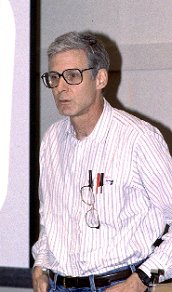
One problem that they had was the source of time information. Each observer has to record their visual or camcorder observations in a way that can be related to Universal Time. They tried to use the Weather Channel as a time source by recording the Weather Channel signal as part of their observation. Unfortunately, any time source that runs over the communications satellites could have variations of over two seconds depending on how the signal is routed through various satellites and ground stations. Hence using television as a time base requires use of local signals only, and as such there must be a master tape made for each local signal area. This increases the number of master tapes that need to be made and the number or coordinators required to get detailed occultation data from across the country.
In addition to lunar occultations, IOTA also supports minor planet occultations. For these, image quality is not as important, only the actual timing of the disappearance or reappearance of the star being occulted by the minor planet. Video recording allows the precise timing of each of the events. These cameras can allow 8-inch telescopes to observe ninth to tenth magnitude stars being occulted. These cameras are usually security cameras and do not generally have recorders built-in. The amateur will have to get a battery-powered TV/Video Recorder combination to make the observations at a remote site.
Amateurs can really contribute in this field. Astrometry of the minor planets before an occultation has greatly improved the prediction of the tracks, and e-mail has allowed the observers in the occultation zone to be alerted to the shifts in the path of the occultation at the last minute.
IOTA is trying to build a database of potential observers for these events. There is a web site that will provide you the latitude and longitude of a site based on just a mailing address. This allows an alert message to be sent out selectively to the observers in the newly predicted path of a minor planet occultation. IOTA hopes that more observers will register themselves in their database.
 The
British Astronomical Association's Saturn Section Director David Graham
described the structure of the BAA. The BAA was founded in 1890 to allow
amateurs to contribute observations and to popularize astronomy. The BAA
Section Directors have been well-known astronomers that have contributed
greatly to the science of astronomy. They function as gatekeepers, eliminating
poor or incorrect observations. From the remaining good observations,
Section Directors summarize and analyze the observations and provide a
final report on each observing season. They also provide alerts of interesting
events and papers on specialized observations.
The
British Astronomical Association's Saturn Section Director David Graham
described the structure of the BAA. The BAA was founded in 1890 to allow
amateurs to contribute observations and to popularize astronomy. The BAA
Section Directors have been well-known astronomers that have contributed
greatly to the science of astronomy. They function as gatekeepers, eliminating
poor or incorrect observations. From the remaining good observations,
Section Directors summarize and analyze the observations and provide a
final report on each observing season. They also provide alerts of interesting
events and papers on specialized observations.
The BAA currently has more than 2,000 members. They produce a yearly Observer's Guide and newsletter every two months. They also maintain a web site.
The various sections are still lead by well-respected astronomers that have studied their area of interest in great detail. Their Sections include Mars, Jupiter, Saturn, Meteor and Comet Sections. These sections have made almost continuos observations back to the founding of the BAA, with only a few interruptions for such minor inconveniences as world wars, when opticians and amateur astronomers went off to fight or make optics for the military. Their observations and drawings are among the best in the world.
The final speaker was Barry Beaman of the Astronomical
League. The Astronomical League is an organization of more than 15,000
amateur astronomers. It was founded over 50 years ago by Harlow Shapley.
The AL is a training and outreach organization. Their observing awards
have started to attract high school science clubs to become members so
they can participate in such programs as the Messier Club and the Herschel
Club. The AL also sponsors a National Young Astronomer Award for high
schoolers that have developed highly scientific astronomy projects. The
award winner receives a Meade LX-200 and a lifetime observing pass to
McDonald Observatory. Meade Instruments provides financial support for
this program.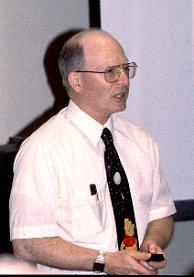
[Insert List of Clubs]
Certificates are recognized in their quarterly newsletter the Reflector. This newsletter is mailed to the entire membership on a quarterly basis. It ranges from sixteen to twenty-four pages with many of them in color. It is an effective communications tool to reach a large part of the amateur community.
The AL also sponsors many conventions. Regional conventions are held in each of their ten geographical Regions. These conventions range from one-day paper-centric events to week-long star parties. They also have a four-day national convention, usually in July, whose venue moves around the country. This event allows amateurs from all over the country to gather together to discuss observing techniques and the science of astronomy.
The Astronomical League also publishes Astro-Notes, short articles on various topics of astronomy and astronomical society advertising. They also publish a series of "Observe" manuals that are available from their Sales Office. These manuals provide a basis for training the novice observer in the techniques of observing specific astronomical phenomena. The AL is a great source for amateur astronomers to learn how to observe, keep records, and to report their observations to a professional astronomer or observing organizations.
After a short break, a group of amateurs and professionals convened to discuss how amateurs and professionals can work together. The Kelly Beatty suggested that there needs to be a central database of amateur astronomers that would contribute to professionals and their research. Alternatively, the observing organizations such as ALPO, AAVSO, and IOTA can channel observations to the professional astronomers.
Those professionals who had actually worked with amateurs in research felt that they would much rather deal directly with the amateur than have to work through an observing group. This allows them much better control of the data taking and data quality. They also felt that the process of determining whom they would accept as observers should make use of the concept of a self- selecting application form. The ALPO felt that they did not have the capacity to manage this database, but the AL is capable of doing it.
The professionals felt that the database should be accessible to them via the Internet. Observers would register on the ‘Net and only authorized professionals would be able to search the database. They would like to be able to enter a set of criteria and receive a list of possible observers and their e-mail addresses. The researcher would then send out an application form that would include requests for information that those who would be capable of making the observations would probably already know. Those who were unable to complete the form would rule themselves out of the program.
 Kelly also suggested a training program to bring amateurs to
the point where they would be able to make observations without any hand-holding
from the professional astronomer. The ALPO's Novice Observer's Handbook
and the AL's Observe manuals could form a basis for a series of courses
with tests at the end to prove that the amateur is capable of performing
the observations. The professionals felt this would not be necessary,
as the application form would weed out those who could not make the observations.
Kelly also suggested a training program to bring amateurs to
the point where they would be able to make observations without any hand-holding
from the professional astronomer. The ALPO's Novice Observer's Handbook
and the AL's Observe manuals could form a basis for a series of courses
with tests at the end to prove that the amateur is capable of performing
the observations. The professionals felt this would not be necessary,
as the application form would weed out those who could not make the observations.
One important thing was to determine before the observations began how the contributions of the amateurs were going to be acknowledged. There had been cases where amateur contributions had been complete unacknowledged in the research paper. Everyone considered this to be unfair. Among the possible options are a listing in the "Acknowledgments" section of the paper or even listing the amateurs as coauthors.
One way to repay the amateurs is to provide them filters, software, data recorders, or even trips to workshops funded out of the research grant. After the program was completed, the amateur could keep these items for future observations.
It was suggested that the professional who was using the service could provide part of the operating cost of the web database by contributing some of their funding to the project. This would make the database a joint operation of the AAS, ASP, AL, NASA, and NSF. Everyone felt this would be a workable solution.
Kelly stated that the DPS business meeting would be discussing pro-am cooperation. Steve Edberg said he would help represent the opinions of the group to the DPS along with Kelly. With that the meeting came to an end. It seemed to be a great first step to building permanent professional-amateur cooperation.
Return to Astronomical League Home Page.
This page is maintained by Matt Ganis for the Astronomical League. Comments, corrections, and suggestions can be addressed to webmaster@astroleague.org. This page last updated January 26, 1999.